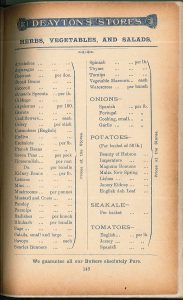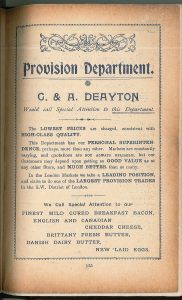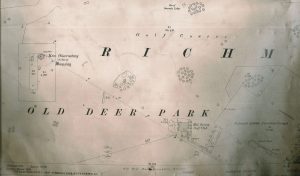Follow the Drum: Life’s Essentials
Patricia Moloney, Local Studies Assistant, considers the problems caused by food shortages in everyday life for the local community during the crisis caused by the First World War. Local Authorities had a key role to play in offering solutions, supporting and managing the food supply. The aim was to maintain adequate supplies and forward plan to secure the necessities of day to day existence for the families of the borough. Education and instruction also had a significant part to play whilst seeking a balance between supply and demand. Food economy and self-sufficiency became the new norm.
Even at the onset of the war in 1914 the local councils took steps to protect the supply and cost of foodstuffs and fuel. For example, by February 1915, Barnes Council had passed a resolution to urge H. M’s government to act immediately to prevent the prices of necessities being unnecessarily increased. This was to become a major element in securing a successful outcome to the war effort as a whole and in preserving stability on the home front.
Growing potatoes – a home grown necessity
By the end of January 1917 there was such an acute shortage of that basic staple, the potato, that the Education Committee of Richmond Council commissioned a series of informative talks for the amateur grower or plot holder, the ‘cottager’, to support production efforts. This food crisis had been going on for more than a year at this point and according to the expert (Mr J. B. Riding, F. R. H. S) with regard to this basic staple of the everyday diet, it was due to the poor quality of the seed. The talks took place at the Technical Institute, Kew Road. His lecture was on ‘The Potato’ and there was an encouraging attendance.
The importance of correct techniques
This was considered such an important subject for the small grower that the speaker overcame a serious cold to deliver his lecture. It was the second talk of the series arranged for allotment holders. Everyone had to fall into line, as the President of the Board of Agriculture had announced that potatoes must be grown everywhere. 1916 had been very unfavourable for the growth of the potato, resulting in a great shortage of the seed potato and a poor return on the crop.
The emphasis on was on early purchase of the available seed in order to avoid disappointment. A good deal of the disappointing potato yields had been due to a lack of understanding about it being a speculative crop. The two main conditions for success were adequate preparation of the soil and good weather conditions. The soil in the Richmond area was thought to be ‘easy’ for cultivating this crop.
The recommended amount of super-phosphate to improve the soil condition was 3 – 4 ounces per square yard with the expert advice not to overdo it. An alternative, according to Mr Riding was sulphate of ammonia used very sparingly (half an ounce to the square yard being deemed sufficient). Correct knowledge and appropriate growing techniques were considered to be paramount to a successful harvest.
The occupation of vacant land
Meanwhile at this time, discussions about vacant land that could be used for this purpose were taking place in meetings of Richmond Council’s Allotments Committee and being minuted as well as reported in the local press (The Thames Valley Times, January 1917). The Council had been empowered to enter unoccupied lands and use them for Allotment purposes. A letter from the Board of Agriculture and Fisheries had been sent to them, enclosing a copy of the Cultivation of Lands Order, 1916.
One example of this was the identification of vacant land in King’s Road. Notice was given to the owner of the land on the east side of King’s Road, between Worple Way and Tudor House that the Council proposed to enter the land to arrange for its cultivation. This was considered to be an urgent necessity at that stage in the national crisis.
Distribution of Seed Potatoes
The Allotments Committee had close links with Surrey County War Agricultural Committee which enabled them to benefit from a scheme for the distribution of seed potatoes, financed by the Treasury. It was the responsibility of the Council to ascertain the quantity of seed potatoes required in the district. The maximum to be supplied to each grower was no more than 5 cwt and the Committee played an active role in securing these supplies.
Detailed plans for the purchase of good quality seed potatoes (Class 1 seed grown in Ireland and Scotland 1916; Class 2 seed grown in England 1916) can be read in the Council Minutes for 1917. Varieties under consideration were Arran Chief and King Edward VII though it was impossible to obtain definite figures for costings so pricing (unusually) remained undetermined at that point.
Staking out plots
The Office of Woods had also consented to permit cultivation of 7 acres of land at Old Deer Park. It was subject to 7 strict conditions documented in the Council minutes (January 1917). The plots at that location were staked out in 10-rod plots and were oversubscribed due to the great need for fresh produce. Numerous plot holders had already started to dig their plots over, preparing the land to be cultivated instead of laying fallow as parkland. This would be difficult digging and reflects how essential it had become to supplement people’s daily diets with locally produced fresh vegetables.
Increasing demand
By February of 1917 the Council was approaching the Office of Woods for more land at the Old Deer Park Allotments site in order to create more plots. These additional plots were subject to the same terms and conditions as before. The Cultivation of Lands Order, 1916 became superseded by the Cultivation of Lands Order, 1917 (No. 2). Under this new order the Local Authority was empowered to enter any land, whether occupied or unoccupied without the necessity of obtaining the consent of the owner or occupier. Land in High Park Road was offered to the Council for the production of food by Messrs. Boore and Parker. This land was subsequently let as 6 allotments.
The Council used the Cultivation of Lands Order, 1917 to enable them to enter land to arrange for its cultivation as allotment land in the Kew Road District (the North and South sides of Old Deer Park Gardens at the junction with Kew Road). Similarly, land was identified for cultivation in Worple Way. In total, at this point the Council applied the Cultivation of Lands Order, 1917 to 36 acres of land.
Sheep!
Access to the additional plots was also an issue. One example of this was the need for a gate to be erected to enable new plot holders to enter the allotments in Old Deer Park when it was closed to the general public. In January 1917, the Borough Surveyor was authorised to work with the Mid-Surrey Golf Club to construct the small temporary gate in the fence between the Golf Club Road and the Old Deer Park (this was also in consultation with the Office of Woods). One problem that needed particular attention was to prevent the sheep getting through from the Golf Club! The gate would need to be self-closing or incorporate a device to stop the sheep entering (in other words a sheep proof device was required).
Local food supply
The Allotments Committee was therefore directly dealing with the question of increasing the food supply locally at that time of crisis. Surrey County War Agricultural Committee asked the Council to appoint a District War Agricultural Committee. (Teddington UDC minutes at that time indicate that they did not see the need to make appointments to such a body though obliged to do so). Simultaneously, other practical initiatives involving the representation of farmers or people with Horticultural experience were put forward for development.
Supplies and further support
Returning to the potato question, by late spring 1917 the Council had purchased and distributed 6 tons of seed potatoes through the County War Agricultural Committee to supply the allotment holders. The next steps that were taken focused on the prevention of disease on the crop to encourage all cultivators to spray their potato crop.

Education and instruction again played a role in enabling this to happen as the Food Production Department arranged for a demonstration to take place on the Old Deer Park Allotments in May 1917.
Despite these endeavours, there were on-going difficulties combatting an outbreak of potato blight during the growing season of 1917.
Blight
Following several inspection visits to various plots by the Food Production Department of the Board of Agriculture, this was reported in the Council Minutes. This situation became complicated in part by the late delivery of the spraying machine from the Food Production Department, and the expense of purchasing the necessary chemicals for individual plot holders.
To assist allotment holders, the Allotment Committee made arrangements for the cultivators to be provided with a sufficient amount of material for spraying purposes free of cost. This reflects how important a priority it was to deliver a good harvest for the local population and the great need to ease pressure on national supplies.
Motivation
The Allotment Committee also reported that prize was also offered by Dr Hunt (a Councillor) to growers for the best crop of potatoes per rod produced on the new allotments during the season of 1917. This amounted to £2.00 per rod and was intended to act as an incentive to inspire growers to persevere in their efforts. Dr Hunt even developed a set of rules for the Prize Scheme to provide a framework for the competition.
The educational programme that supported growers totalled 6 lectures that were well attended. Once that series was completed, other practical topics such as bee-keeping and poultry-rearing were addressed to enable individuals to gain maximum benefit from this new drive towards cultivating the land.
Experience the impact of these struggles and shortages on the local community in the borough by accessing the original archive material. Visit the Local Studies Library & Archive, Old Town Hall, Whittaker Avenue, Richmond, TW9 1TP. The opening times are displayed here.
Images used in this blog item are taken from the 1913 O/S map of Richmond (LM 0525) and Deayton’s Stores Sales Catalogue (L 658.874 T).
The Local Studies Team is happy to help you successfully conclude your enquiries about the First World War in the borough.
[Patricia Moloney, Local Studies Assistant]

